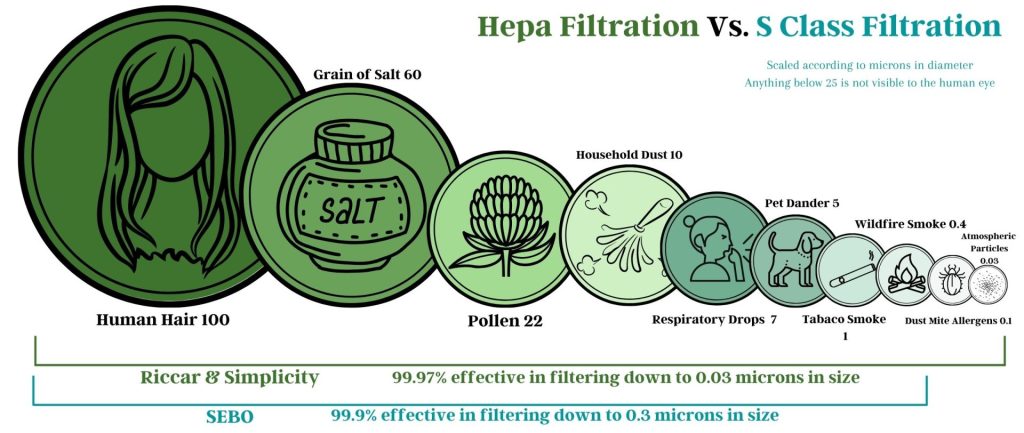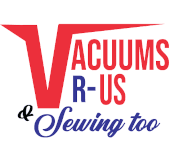Sebo Vacuums – S-Class Filtration

When it comes to keeping your home’s air clean and dust-free, having a high filtration vacuum is a must. Sebo vacuums have long been known as the industry standard for safe and efficient cleaning and improved indoor air quality. Sebo vacuums are designed with powerful motors that create an effective suction to ensure proper dirt and dust removal from carpets, rugs, upholstery, stairs, and other surfaces throughout your home. Sebo vacuums also use multiple stages of filters to capture the finest particles from the air stream before they go back into the environment. Sebo uses their patented S-Class Filtration system to ensure the best mix of filtration and efficiency. It might get you thinking, however, what is the difference between standard HEPA filtration and Sebo’s S-Class Filtration and are Sebo vacuums worth the money?
Sebo S-Class Filtration vs. HEPA Filtration
There are several key differences between S-Class Filtration and HEPA filtration. Sebo vacuums are widely recognized for their superior filtration capabilities, thanks to their use of two different kinds of filters: S-Class Filtration and HEPA. While both versions are designed to keep the air clean of dust, allergens, and other particles, there are some important differences between the two designs. After most debris has been caught within the vacuum bag, S-Class Filtration begins with a large electrostatic charged filter that collects tiny particles in the vacuum’s airflow. These particles are then passed into smaller post motor filters which capture even smaller particles in the airstream. Sebo’s S-Class filtration utilizes electrostatic filters because it allows more airflow, and therefore more suction power, to be created from the vacuum. This increases both efficiency and cleaning power. S-Class filtration is 99.9% effective at removing particles down to 0.3 microns in diameter. To put this in perspective, a human hair is about 100 microns in diameter. More advantages of S-Class Filters are that they are a relatively open texture that allows smoother airflow for better suction performance, a longer life expectancy, and they cost less than HEPA filters.
On the other hand, HEPA filters block up to 99.97% of airborne pollutants down to 0.3 microns in diameter by utilizing tiled fibers that act as a sort of mesh screen that blocks tiny particles. This tiny screen can become clogged with dirt and debris overtime, and could cause a loss of airflow.
While all Sebo vacuums do come pre-installed with S-Class filtration, they do allow people to change out their filters for their HEPA filtration bags and filters if they so choose on all of their upright vacuums and canister vacuums.
Video: Sebo S-Class Filtration
In the video below, Josh, our certified Sebo repair technician, is going to explain the differences between S-Class filtration and HEPA filtration. He will also explain the advantages that S-Class filtration brings to your Sebo vacuum and your home.
My name is Josh over here at VacuumsRus and Sewing Too in Arvada and Boulder, Colorado. Today I am going to define S-Class and HEPA filtration. The definition of S class Filtration is that it filters out 99.9% of particles down to 0.3 microns. HEPA filtration – the standard in the USA – Is 99.97%. of particles down to 0.3 microns. HEPA filtration technically will filter out more particles than will S-Class filtration depending on how you look at it. For HEPA filtration to say that I have a HEPA vacuum cleaner, we don’t have to consider the fact that the vacuum is not fully sealed. It could be spewing dust out of every pore. All we’re talking about is that the final HEPA Filter is HEPA grade.
Let’s talk about the practical real-world implications of S-Class filtration and it’s 99.9% versus HEPA filtration and it’s 99.97%. These are some things that we saw at the beginning of the pandemic. We saw lots of debates about whether masks work and what is HEPA filtration and does it block viruses and are the viruses attached to a particle. The reality is, is that the more effective our filtration and the finer the material is that we are pushing our air through, the lower air flow will be and the more strain we’re going to put on our motor. If we filter down to a particle size or to a level that is too extreme, then you’re going to see lower performance on the machine because you’re not pulling in as much air. Another thing that you’re also going to see is a lesser lifespan on the motor because the motor is having to work so much harder.
Now, looking at what does 0.3 microns mean? What does it mean when we say that we’re filtering out 99.9% of stuff that is 0.3 microns? Well, wildfire smoke is 0.4 microns, so even larger than 0.3 microns. Pet dander is 5 microns, household dust, just general dust is about 10. Respiratory drops are very large at 7 microns. Tobacco smoke is 1 micron, which is 3 times larger than 0.3 microns. We need to talk about the realities of what we are filtering and using HEPA filters for. We’re slapping these on, in many cases, poorly designed machines that are leaking air anyway. Are we slapping these HEPA filters on for marketing purposes or is there a practical reason why we want to put a HEPA filter on the machine? I would debate that filtering out 99.9% of particles that are stinking tiny is an incredible achievement, particularly when we consider the overall design of the machines.

